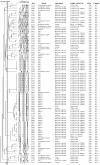Predominance of Klebsiella pneumoniae ST14 carrying CTX-M-15 causing neonatal sepsis in Tanzania
- PMID: 24099282
- PMCID: PMC3851032
- DOI: 10.1186/1471-2334-13-466
Predominance of Klebsiella pneumoniae ST14 carrying CTX-M-15 causing neonatal sepsis in Tanzania
Abstract
Background: Klebsiella pneumoniae strains expressing ESBLs are a predominant cause of hospital acquired infections. Here we describe the molecular epidemiology of these isolates in a tertiary hospital in Tanzania, as potential pathogens for neonatal infections.
Methods: Between April 2009 and March 2010 all Klebsiella pneumoniae isolates with phenotypic expression Extended Spectrum Beta Lactamase (ESBL) were collected and characterized. Identification was done using in house biochemical tests in case of ambiguous results confirmation was done using API 20E. Susceptibility testing was determined using the disc diffusion method followed by specific PCR and sequencing to determine ESBL genes. Phylogenetic analysis, Pulse field gel electrophoresis (PFGE) and Multi-Locus sequence typing (MLST) to PFGE clusters representative isolates were performed to determine clones of the isolates. Conjugation and hybridization were performed to determine the location of blaCTX-M-15 gene.
Results: A total of 92 non-repetitive ESBL producing K. pneumoniae representing 50.3% of Klebsiella pneumoniae isolates were characterized. These isolates were from blood 61 (66%), wound swab 13 (14%), urine 12 (13%) and pus 6 (7%) were analyzed. Most blood culture strains originated from neonatal unit 39/61(64%) and 22 (36%) of the blood culture isolates were from neonatal ICU. All isolates were resistant to gentamicin and 54% were resistant to ciprofloxacin. Using a similarity index of 80%, the isolates were assigned to thirteen clusters based on PFGE patterns and contained sub-clusters with identical strains indicating clonal outbreaks. Cluster X5, X7 and X8, and X9 were grouped into ST48, ST14 and ST348 respectively. Based on gyrA PCR- RFLP phylogenetic analysis all isolates were grouped as KpI. The predominant ESBL allele detected was blaCTX-M-15 which was found in 76% of isolates, followed by blaTEM-104 (19%), blaSHV-11 (3.2%) and blaTEM-176 (2%). The blaCTX-M-15 gene was located in multiple conjugative IncF plasmids ranging from 25 kb-485 kb in size.
Conclusion: The high prevalence of blaCTX-M-15 observed among ESBL producing K. pneumoniae in Tanzania, is possibly due to the spread of a common IncFII 145 kb plasmid and of certain clones such as ST14 and ST48. Furthermore the 485 kb plasmid detected is the largest plasmid reported to carry blaCTX-M-15 todate.
Figures


References
-
- Mshana SE, Imirzalioglu C, Hain T, Domann E, Lyamuya EF, Chakraborty T. Multiple ST clonal complexes, with a predominance of ST131, of Escherichia coli harbouring blaCTX-M-15 in a tertiary hospital in Tanzania. Clin Microbiol Infect. 2011;17(8):1279–1282. doi: 10.1111/j.1469-0691.2011.03518.x. doi:10.1111/j.1469-0691.2011.03518.x. - DOI - PubMed
-
- Bloomberg B, Jureen R, Manji KP, Tamim BS, Mwakagile DSM, Urassa WK, Fataki M, Msangi V, Tellevik M, Maselle SY, Langeland N. High Rate of Fatal Cases of Pediatric Septicemia Caused by Gram-Negative Bacteria with Extended-Spectrum Beta- Lactamases in Dar es Salaam. Tanzania J Clin Microbiol. 2005;43:745–749. doi: 10.1128/JCM.43.2.745-749.2005. - DOI - PMC - PubMed
Publication types
MeSH terms
Substances
LinkOut - more resources
Full Text Sources
Other Literature Sources
Medical
Miscellaneous

